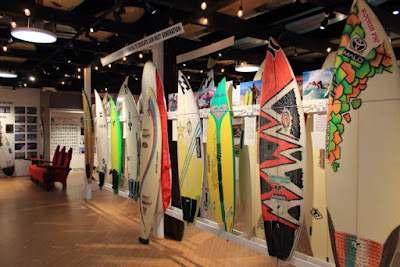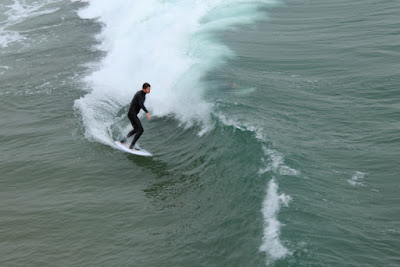The area now known as Huntington Beach (California) was originally occupied by the Tongva people and then became part of Rancho Los Nietos, a 300,000 acre Spanish land grant. Beach Boulevard, the main thoroughfare through Hunting Beach, was the main cattle trail through Rancho Los Nietos.
In 1790, the land was acquired by Mission San Gabriel. Over the years, the community around the mission was known as Shell Beach, Smeltzer, Fairview, Pacific City, then Huntington Beach after railroad magnate Henry Huntington. The marshland where Golden West College is now located was known as "Gospel Swamp" because of the many revival meetings held at the site.
Huntington Beach is a surfer's paradise with sandy beaches, mild climate, and consistent surf. The "ocean waves are enhanced by a natural effect caused by the edge-diffraction of open swells around Santa Catalina Island. Swells generated predominantly from the North Pacific in winter and from a combination of Southern Hemisphere storms and hurricanes in the summer focus on Huntington Beach creating consistent surf all year long;" thus, the nickname and registered trademark for Huntington Beach is "Surf City USA."
The International Surfing Museum is located in Huntington Beach and was "created to honor those individuals who have contributed to surfing and it's culture and are deserving of recognition, but might not qualify to receive a stone on the [Surfing] Walk of Fame." The museum is dedicated to Duke Kahanamoku, the Hawaiian who popularized the sport of surfing.
Within the museum are historic surfboards, information about legendary surfers, art work, and visitors can watch a variety of surfing films while listing to surf music. Although I tried surfing a few times, I didn't find my name in the museum. I think it is because when I tried surfing they gave me a "tourist board," which is long, wide, and heavy. I about dislocated my shoulders just trying paddle out past the point where the surf breaks. However, I did manage to stand up on the board; but I had a little problem with the turns. I think I would have been better off with a smaller board.
In the parking lot outside of the International Surfing Museum building is the "World's Largest Surfboard," measuring over 42 feet long and 11 feet wide. On June 20, 2015, 66 people set a Guinness World Record when they demonstrated the surfboard worked by catching a wave and all 66 people rode the surfboard at the same time. The board is kept in "surf ready condition" just in case their record is challenged.
Located at the northeast corner of Main Street and Pacific Coast Highway is the Surfing Walk of Fame, which consists of inlaid stones recognizing individuals that won championships and/or significantly contributed to the sport of surfing.
Located directly across the street from the Surfing Walk of Fame is the Surfers' Hall of Fame, which recognizes 2 or 3 new people each year. Nominations are taken from the surfers at large, but the final selection is made by a committee.
Construction started on the Huntington Pier in 1902 and since that date the Pier has been extended and rebuilt a number of times. At 1,850 feet long, it is now the second longest public pier in California.
The Pier is a great place to stand and in order to watch surfers demonstrate their skills.
Located at the end of the Pier is Ruby's Diner that has a '50s atmosphere with a Hawaiian themed dining area on the second floor. Great place to watch the sunset while eating a hamburger/fries and listing to surfer music by the Beach Boys.
On Tuesday evenings there is a Farmers Market on Main Street that has very little farm produce and mostly art works, crafts, and tourist trinkets.
As the sun dropped beyond the horizon, the sunset was beautiful; but I wondered why I forgot to bring a jacket!
BONUS PICTURE
 |
| Quilting Creations by Linda |














































No comments:
Post a Comment